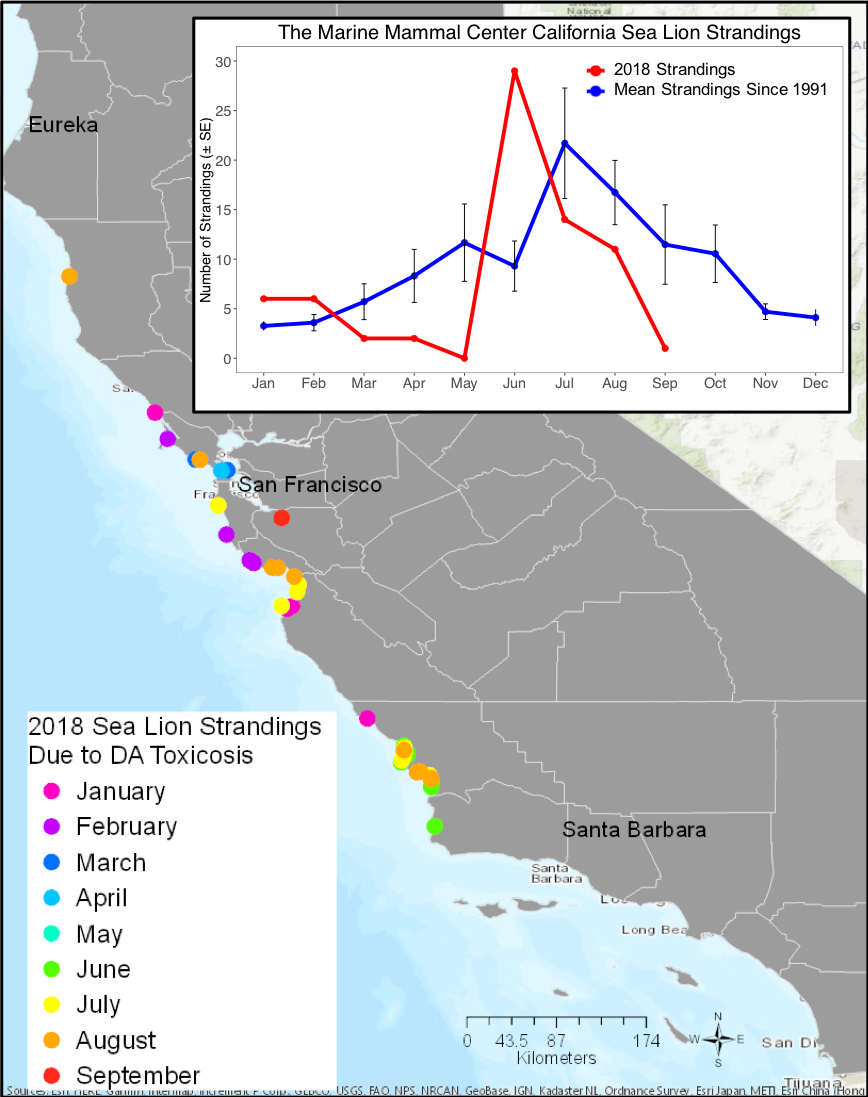Pseudo-nitzschia - C-HARM tells us where conditions are suitable for Pseudo-nitzschia spp. (all size classes) to grow well and where they might be more likely to produce domoic acid. In July, the probability of a Pseudo-nitzschia spp. bloom was still high all along the coast with some low offshore probabilities in the Southern California Bight near Orange and San Diego Counties. High nearshore probabilities of a Pseudo-nitzschia spp. bloom in Orange County were consistent with Harmful Algal Bloom Monitoring and Alert Program (HABMAP) weekly sampling at Newport Beach Pier, and to a lesser extent, Stearns Wharf in Santa Barbara. The only location where the weekly HABMAP pier sampling by SCCOOS and CeNCOOS showed high potential for a toxigenic Pseudo-nitzschia bloom (large "seriata" size class) was at the Newport Beach Pier in mid-July, although many of the sites did not have newly archived data with which to compare C-HARM predictions, particularly for the second half of the month. Keep in mind that C-HARM Pseudo-nitzschia spp. predictions do not discriminate between toxigenic and non-toxigenic species.
Domoic Acid - C-HARM predicted the highest likelihood of particulate domoic acid (pDA) production in the Southern CA Bight, the offshore region of central CA, and in the nearshore zone of the North Coast. Cellular domoic acid (cDA) predictions, which should tell us where Pseudo-nitzschia cells are likely to be most toxic on a per-cell basis, indicate that the Southern CA Bight is not currently a hot spot. The North Coast near Humboldt County and the central CA coast near Monterey Bay are regions predicted to have the highest cellular DA concentrations in July. Unfortunately, DA values from the HABMAP sampling are not yet available at any of the pier locations. It may be that the high salinity that has accompanied the record warm temperatures in the Southern California Bight the last two years since the "Blob" is what is driving the high pDA predictions in the region. This is because there is a strong positive relationship between salinity and particulate domoic acid in the C-HARM pDA model. That relationship is not as strong for cDA. In August, central and north coast sea lion strandings from DA toxicosis were in Monterey Bay and near the mouth of Eel River, consistent with elevated pDA and cDA likelihoods (from C-HARM) in those areas.
Alexandrium - The Alexandrium species (spp.) data collected by HABMAP show somewhat elevated Alexandrium spp. counts at the Santa Cruz Municipal Wharf at two time points in the first half of the month. On June 25, the California Department of Public Health (CDPH) lifted health advisories related to sport-harvested bivalve shellfish (whole scallops and all clams) in Santa Barbara, Santa Cruz and Sonoma counties that were in place due to high levels of saxitoxin, the algal toxin produced by some Alexandrium spp. and that is associated with paralytic shellfish poisoning (PSP). Recent testing shows that saxitoxin has decreased to safe or undetectable levels.
Mean Probability of Pseudo-nitzschia Bloom for July 2018
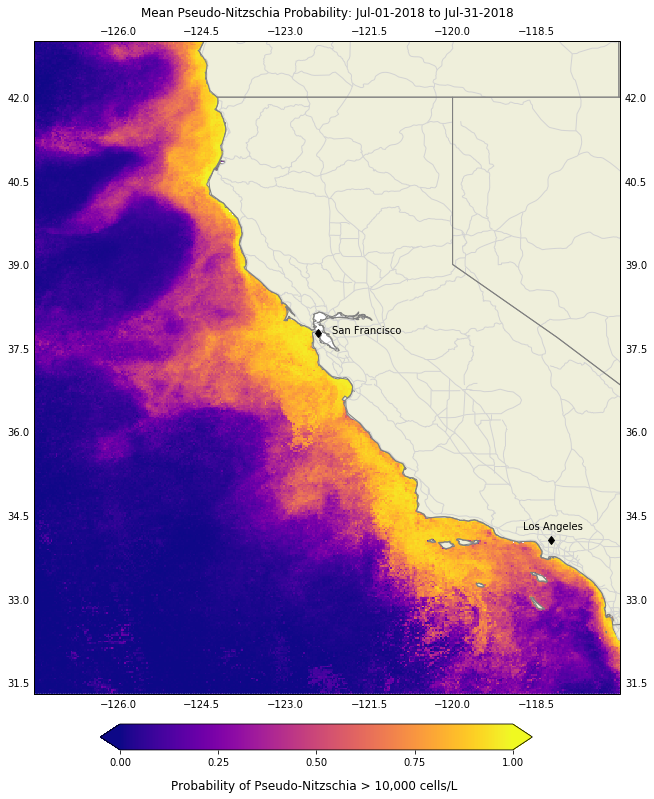
Mean Probability of Particulate Domoic Acid for July 2018
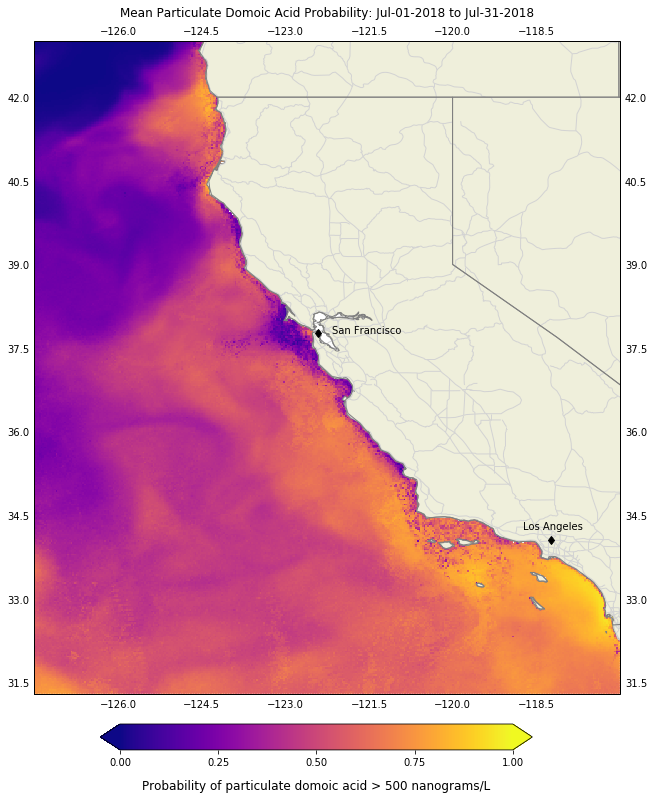
Mean Probability of Cellular Domoic Acid for July 2018

CDPH observations for Pseudo-nitzschia spp. and Alexandrium spp.
Between July 1st to July 31st, 2018, 138 samples were collected by volunteers and sent to the California Department of Public Health (CDPH) for analysis. Pseudo-nitzschia spp. were detected in 86 of the 138 samples. Percent composition of Pseudo-nitzschia was greatest at the Santa Cruz Municipal Wharf on July 18th and July 16th (80% and 30% respectively) and at the San Simeon Pier on July 3rd (69%). Alexandrium spp. were detected at nine of the 90 sites sampled. You can also view CDPH weekly map layers of Pseudo-nitzschia and Alexandrium here.
Note the annual mussel quarantine is still in effect. The mussel quarantine is an annual event that happens due to dangerous levels of biotoxins that may be present in mussels gathered by the public anywhere on the California coast, including bays, inlets, and harbors. For the latest closures and updates, please visit the California Department of Fish and Wildlife (CDFW) Health Advisories page.
Data are provided by the California Department of Public Health, Environmental Management Branch.
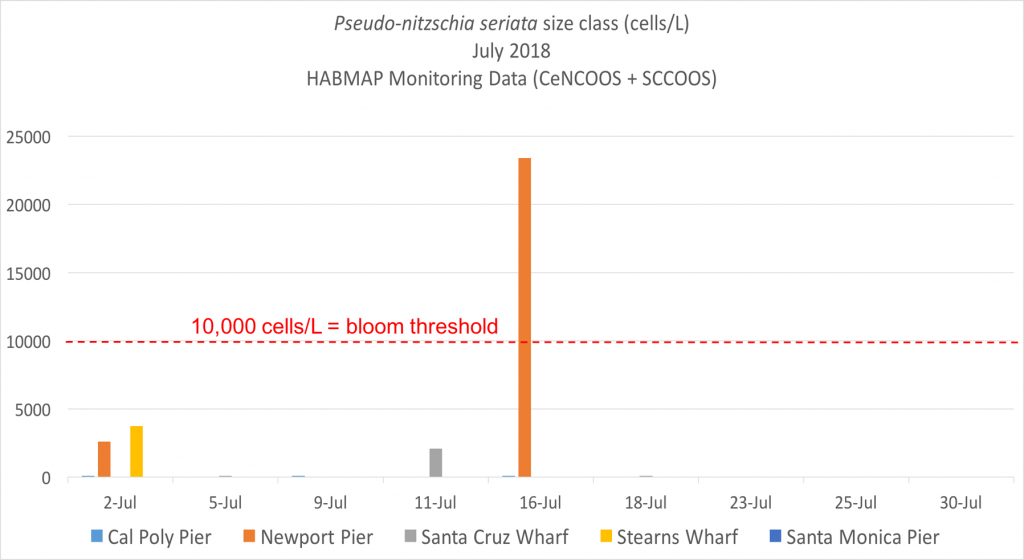
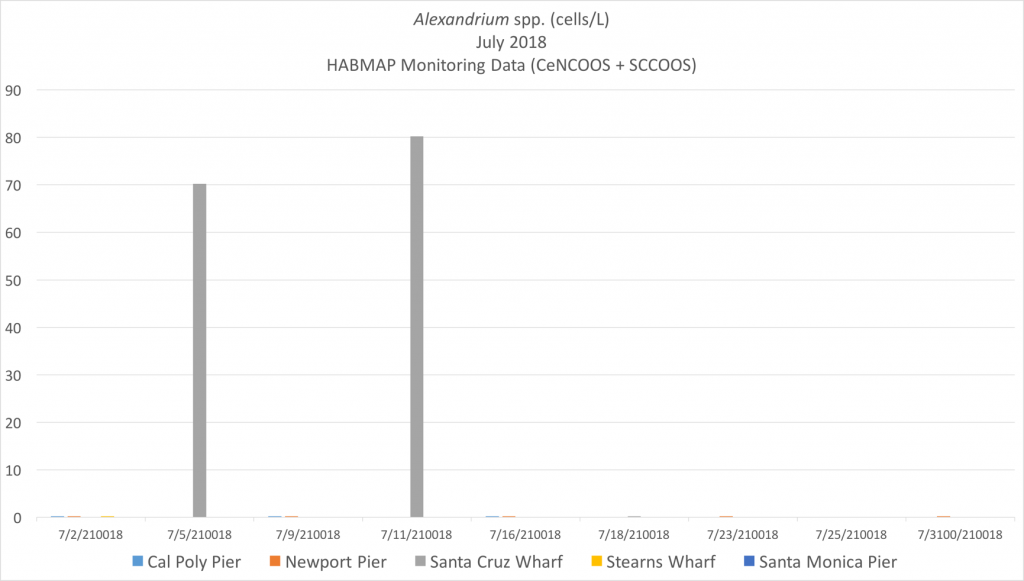
July 1st - 31st 2018
Pseudo-nitzschia spp. Percent Composition
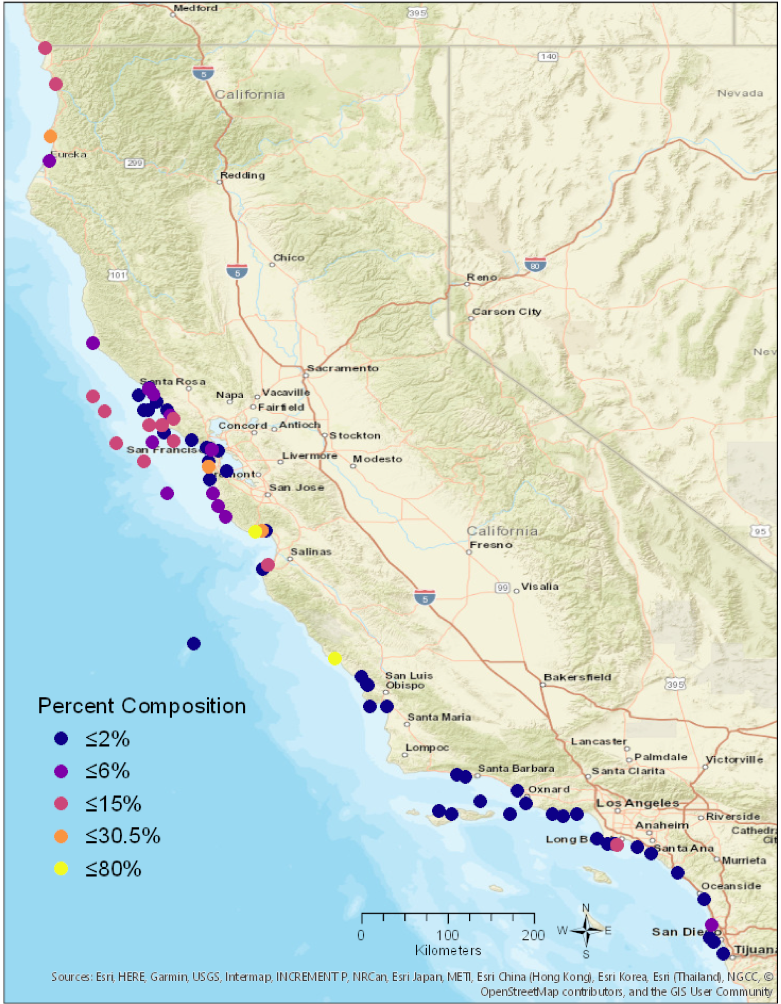
July 1st - 31st 2018
Alexandrium spp. Percent Composition
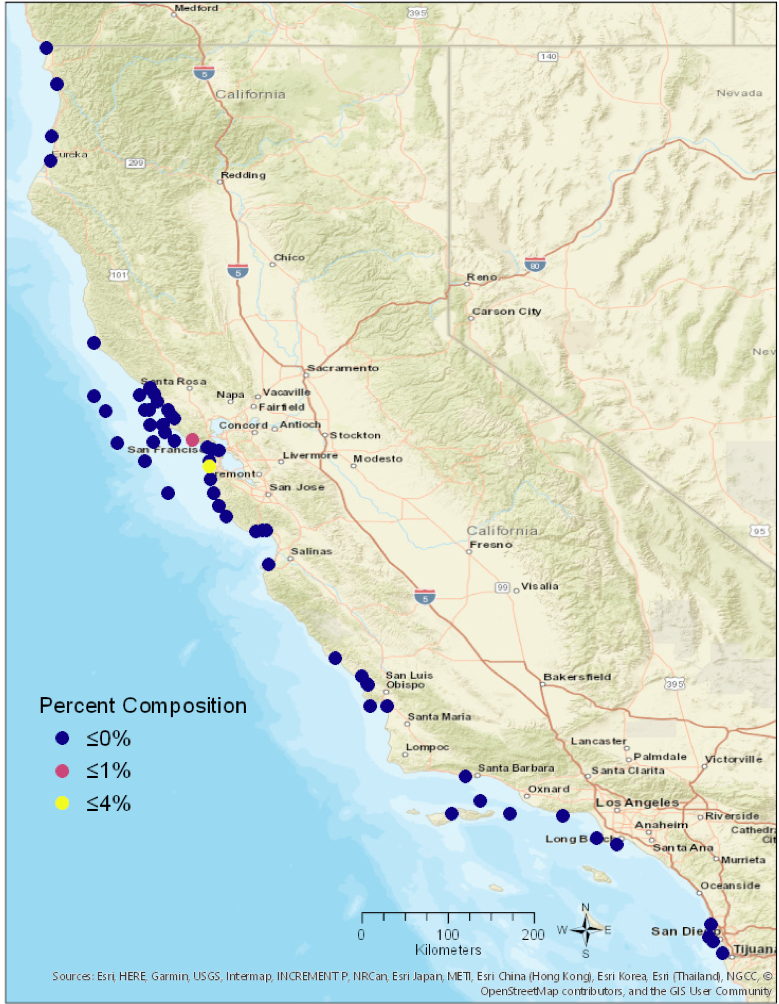
Central California Sea Lion Strandings from DA Toxicosis
The Marine Mammal Center in Sausalito, CA is like an emergency room by working to rescue and rehabilitate sick and injured marine mammals, primarily California sea lions (Zalophus californianus). There have been a total of 72 sea lion strandings presented with domoic acid toxicosis since January 2018 with 14 sea lion strandings in July and a peak of 29 sea lion strandings in the month of June.
No DA toxicosis cases have been reported by the Pacific Marine Mammal Center in 2018.
July sea lion strandings due to DA toxicosis occurred at the following locations:
- July 1st - Morro Bay Harbor, Morro Bay
- July 1st - Morro Strand State Beach, Morro Bay
- July 2nd - Oceano Dunes Entrance Station, Oceano
- July 2nd - Pismo State Beach, Pismo Beach
- July 3rd - Avila Beach, Avila Beach
- July 4th - Morro Bay Sandspit, Morro Bay
- July 7th - Morro Bay Sandspit, Morro Bay
- July 10th - Pismo State Beach Pier, Pismo Beach
- July 11th - Salinas River State Beach, Monterey
- July 13th - Moss Landing State Beach, Moss Landing
- July 19th - Spooners Cove, Los Osos
- July 20th - Dog Beach, Avila Beach
- July 25th - Pillar Point Harbor, Princeton-by-the-Sea
- July 29th - Asilomar State Beach, Pacific Grove
